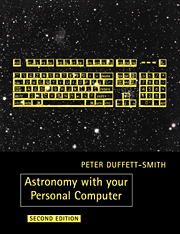Book contents
- Frontmatter
- Contents
- Preface
- Using your personal computer for astronomy
- DEFAULT: default value input routnine & YESNO: ‘Y’ or ‘N’ input routine
- MINSEC: converts between decimal hours/degrees and minutes/seconds form
- JULDAY: calendar date to Julian day number since 1900 January 0.5
- CALDAY: Julian day number since 1900 January 0.5 to calendar date
- TIME: converts between local civil and sidereal times
- EQHOR: converts between equatorial and horizon coordinates
- HRANG: converts between right ascension and hour angle
- OBLIQ: calculates the value of the obliquity of the ecliptic
- NUTAT: finds corrections for nutation in longitude and obliquity
- EQECL: converts between equatorial and ecliptic coordinates
- EQGAL: converts between equatorial and galactic coordinates
- GENCON: converts between any of the coordinate systems
- PRCESS1: approximate precession of equatorial coordinates & PRCESS2: rigorous precession of equatorial coordinates
- PARALLX: converts between geocentric and apparent position
- REFRACT: calculates the effect of atmospheric refraction
- RISET: finds the circumstances of rising and setting
- ANOMALY: solves Kepler's equation for elliptical motion
- SUN: finds the ecliptic coordinates of the Sun
- SUNRS: finds the circumstances of sunrise and sunset
- PELMENT: returns the orbital elements of the major planets
- PLANS: finds the position of a planet
- MOON: finds the position and parallax of the Moon
- MOONRS: finds the circumstances of moonrise and moonset
- MOONNF: finds the times of new and full moon
- ECLIPSE: finds the circumstances of lunar and solar eclipses
- DISPLAY: displays an eclipse in graphical form
- ELOSC: finds positions from osculating elliptical elements
- RELEM: converts elliptic orbital elements from one epoch to another
- PCOMET: finds the position of a comet from parabolic elements
- PFIT: finds parabolic elements from observations & EFIT: finds elliptical elements from observations
- List of variables
- Bibliography
- Index
- PROGRAMS AVAILABLE ON DISK
CALDAY: Julian day number since 1900 January 0.5 to calendar date
Published online by Cambridge University Press: 17 February 2010
- Frontmatter
- Contents
- Preface
- Using your personal computer for astronomy
- DEFAULT: default value input routnine & YESNO: ‘Y’ or ‘N’ input routine
- MINSEC: converts between decimal hours/degrees and minutes/seconds form
- JULDAY: calendar date to Julian day number since 1900 January 0.5
- CALDAY: Julian day number since 1900 January 0.5 to calendar date
- TIME: converts between local civil and sidereal times
- EQHOR: converts between equatorial and horizon coordinates
- HRANG: converts between right ascension and hour angle
- OBLIQ: calculates the value of the obliquity of the ecliptic
- NUTAT: finds corrections for nutation in longitude and obliquity
- EQECL: converts between equatorial and ecliptic coordinates
- EQGAL: converts between equatorial and galactic coordinates
- GENCON: converts between any of the coordinate systems
- PRCESS1: approximate precession of equatorial coordinates & PRCESS2: rigorous precession of equatorial coordinates
- PARALLX: converts between geocentric and apparent position
- REFRACT: calculates the effect of atmospheric refraction
- RISET: finds the circumstances of rising and setting
- ANOMALY: solves Kepler's equation for elliptical motion
- SUN: finds the ecliptic coordinates of the Sun
- SUNRS: finds the circumstances of sunrise and sunset
- PELMENT: returns the orbital elements of the major planets
- PLANS: finds the position of a planet
- MOON: finds the position and parallax of the Moon
- MOONRS: finds the circumstances of moonrise and moonset
- MOONNF: finds the times of new and full moon
- ECLIPSE: finds the circumstances of lunar and solar eclipses
- DISPLAY: displays an eclipse in graphical form
- ELOSC: finds positions from osculating elliptical elements
- RELEM: converts elliptic orbital elements from one epoch to another
- PCOMET: finds the position of a comet from parabolic elements
- PFIT: finds parabolic elements from observations & EFIT: finds elliptical elements from observations
- List of variables
- Bibliography
- Index
- PROGRAMS AVAILABLE ON DISK
Summary
The result of an astronomical calculation is sometimes an instant of time, expressed as a number of days since a fundamental epoch. In our convention, that epoch is 1900 January 0.5, and the number of days elapsed since then is represented by the real variable DJ. For example, we may have calculated the time of the next lunar eclipse as DJ = 30 815.69, but unless we are familiar with the interpretation of such numbers, the result will not mean very much to us. We need a conversion routine to convert a Julian day number into a calendar date, the inverse function of JULDAY.
Subroutine CALDAY performs this function. It converts DJ, the number of Julian days (and fraction of a day) elapsed since 1900 January 0.5, into the calendar date represented by DY, the day of the month including the fraction of the day, MN, the month number, and YR, the year number. The fraction of the day is also returned by FD. Thus DJ = 30815.69 gives DY = 15.19, MN = 5, YR = 1984 and FD = 0.19, from which we conclude that the lunar eclipse was in progress on 1984 15th May at 4 : 33 UT (Universal Time). The integer part of the day number is returned in the variable ID, and a string representation of the entire date in the string variable DT$.
Information
- Type
- Chapter
- Information
- Astronomy with your Personal Computer , pp. 21 - 28Publisher: Cambridge University PressPrint publication year: 1990
